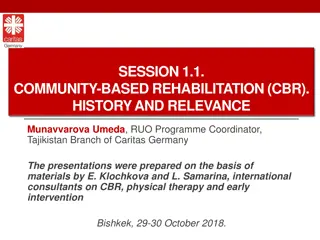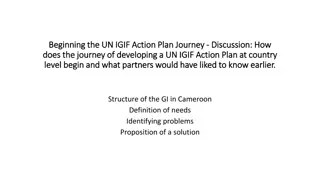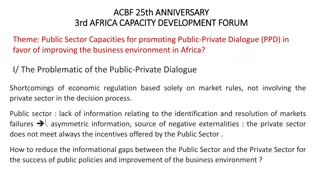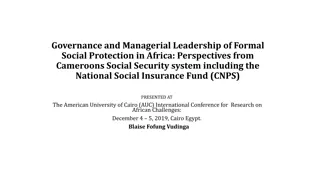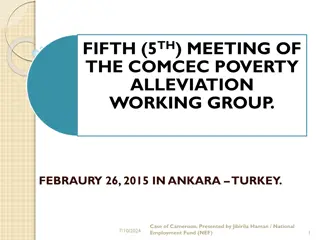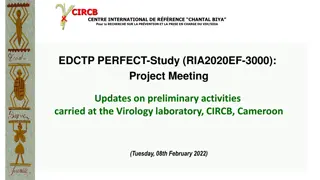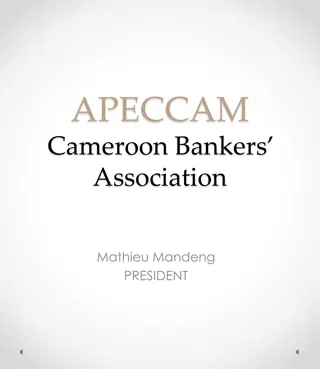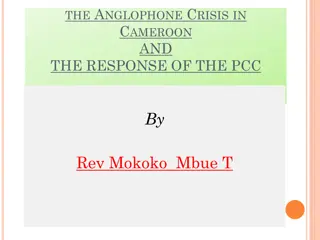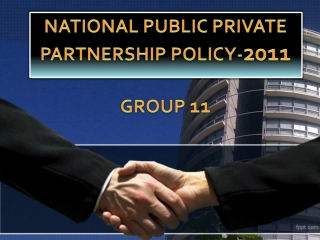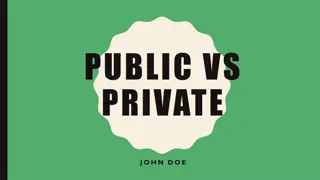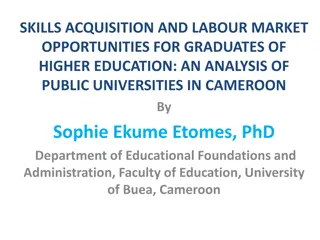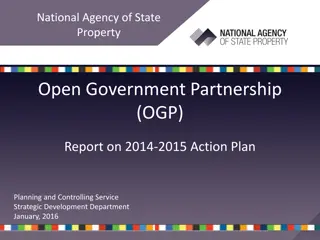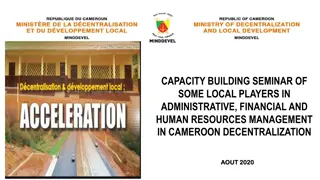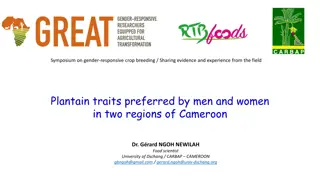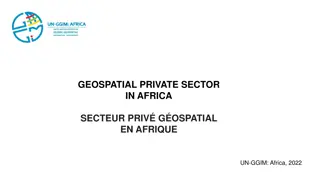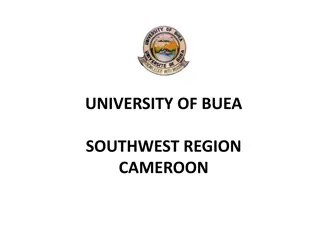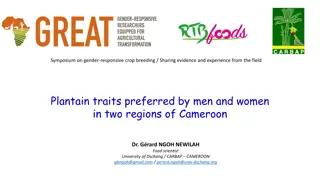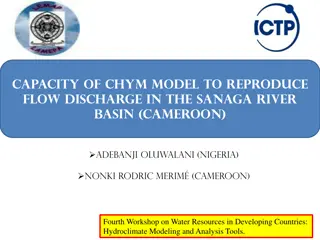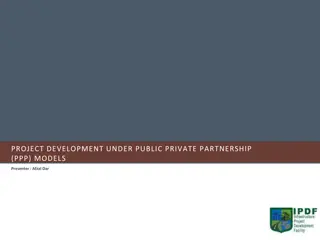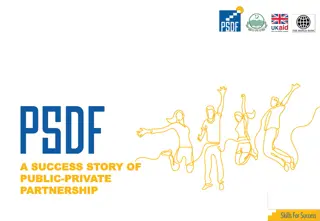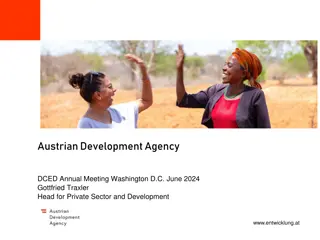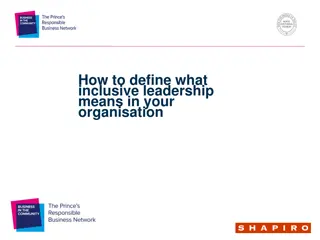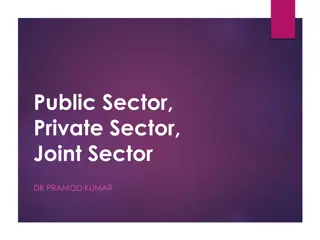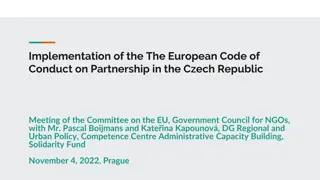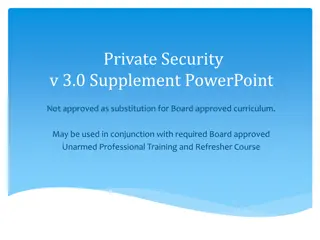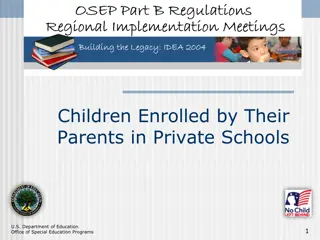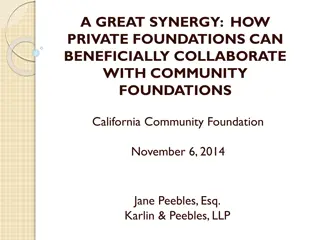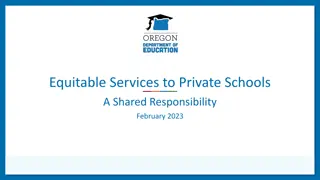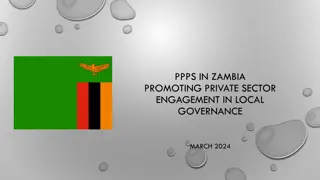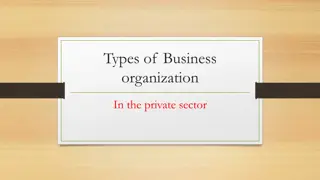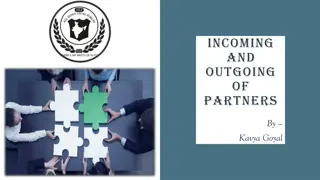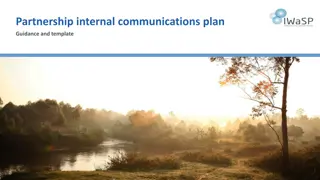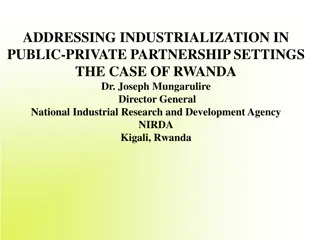Public-Private Partnership Using CBR for Inclusive Development in Cameroon
This article discusses the implementation of a Public-Private Partnership using Community-Based Rehabilitation (CBR) to achieve inclusive development in Cameroon, with a focus on the Northwest Region. It outlines the context in Cameroon, the specific initiatives in the Northwest Region, the methodology used for stakeholder mapping and advocacy, and the areas of intervention including administration and health. The efforts aim to mainstream disability into municipal development plans and promote community-based inclusion.
Download Presentation

Please find below an Image/Link to download the presentation.
The content on the website is provided AS IS for your information and personal use only. It may not be sold, licensed, or shared on other websites without obtaining consent from the author. Download presentation by click this link. If you encounter any issues during the download, it is possible that the publisher has removed the file from their server.
E N D
Presentation Transcript
Public-Private Partnership; Using CBR to Achieve DID Jacques Chirac Awa, Ezekiel Benuh, Kenchi Joseph, Asheri Ngah 2ndCBR World Congress Berjaya Times Square Hotel, Kuala Lumpur September 27th 29th 2016, Kuala Lumpur, Malaysia
Cameroon: Context at a glance Located in central Africa with estimated 20,000,000 inhabitants (Nat.Stat, 2013). Disability prevalence of 5.4% (DHS IV, 2011) Signed the CRPD and enacted N April 13, 2010 on the Protection and Promotion of the Rights of persons with disabilities. 2010/002 of Enacted law N 2004/017 of 22 July 2004 on decentralization.
The Northwest Region: Context at a glance Located in Northwest Region of Cameroon with estimated 2,000,000 inhabitants (Nat. Stats, 2013). 7 Divisions and 34 sub-divisions. Christianity and Islam co-exist with Christianity as main religion. Disability prevalence estimated at 10.2% (Mactaggart et al, 2014) SEEPD Program focuses on the Medical, education, livelihood and social components of the CBR guideline. Currently focused on achieving program sustainability.
Methodology Mapping of development stakeholders in the region conducted. 15 councils selected and targeted for advocacy. Criteria for selecting councils included; administrative structure, population size, and rural-urban dynamics. Advocacy task force comprised of DPO leaders from the targeted divisions, CBR workers, and program staff was constituted to draft and implement an advocacy strategy. Meetings held with mayors of selected councils; draft MoU shared with councils for review and consideration. 4 days advocacy workshop organized on CBR, disability and inclusive development was organized to bring together from each council a mayor and council development officer. MoUs were formalized and opened for action planning. Upon request, technical assistance provided to councils in view of mainstreaming disability into Council Development Plans (CDP). Modifications done on CDPs was informed by the CBR matrix. CBR workers used to accompany the councils on their journey to community based inclusion. Tools were developed both to track performance of councils but also to provide progress reports to council leadership.
Areas of Intervention 1. Administration oExtra-ordinary council sessions were summoned to adopt the signed MoUs. oCouncils appointed Disability Focal Points to lead in mainstreaming disability in municipal development. oTraining workshops on CBR and DID were organized council staff. oWork sessions to design actions plans for disability mainstreaming were organized. o15 councils developed volunteering models and recruited 87 volunteers.
2. Health o Two 14 days training workshops on CBR and DID were organized for 87 volunteers and 14 disability focal persons. The Mayor of Jakiri Council presiding over an outreach planning meeting Add picture that best describe councils involvement in health(preventive care, preventive care etc) o 16 outreach planning meetings were organized by 14 councils. o 13 councils organized community outreaches in collaboration with the medical projects on the Program. This was facilitated by CBR workers. o 2 councils provided assistive devices to 62 needy persons with disabilities and provided medical subsidies to 04 others. o 8 councils in collaboration with regional transport authorities organized campaigns on the safe usage of motorbikes in their municipalities. o 2 councils organized workshops on the theme No Health without Mental Health for 421 people in their municipalities.
3. Education o6 councils identified and assessed the education needs of 362 CWD in their municipalities. Mayor of Kumbo Council sensitizing on the importance of education for CWDs on Mayor s DAY Picture supporting above points. o14 councils established birth certificates and facilitated the acquisition of national disability cards for 108 CWD in their municipalities. o4 councils organized campaigns on the Importance of education to CWDs in 4 communities o07 councils organized pre-school activities for 25 children with hearing impairment. o1 council recruited sign language teachers for 1 state-run secondary school in their municipality.
4. Livelihood o14 councils assessed the livelihood needs of 15 PwDs in their municipalities. Patricia ON CVRT center Embriodery Insert supporting picture. o5 councils involved 8 youths with disabilities in holiday jobs provided by councils. o4 councils adopted inclusive recruitment policies in their municipality.
5. Social o17 councils mainstreamed disability in their policies and action plans. o14 councils organized meetings for 152 development stakeholders on the need to adopt inclusive approaches to development. o14 councils organized 01 capacity building sessions held with 153 PWDs to take leadership roles and responsibilities in community structures with consideration to gender. o15 councils advocated for mainstream sports and recreational activities to adopt inclusive approaches
6. Empowerment o08 councils facilitated the acquisition of birth certificates, disability cards and voters cards for 86 persons with disabilities from their municipalities. o4 council organized community sign language training for 127 people. o 15 councils in collaboration with APWDs broadcast radio campaigns on rights and responsibilities of PwDs. o3 councils in consultation with SHGs of PwDs form 3 DPOs in their municipalities.
Results 1. Increased understanding of the relevance of disability inclusion among municipal authorities demonstrated by requests for partnership received from 4 councils. We need to be sure the 10.2% of our population with disabilities are also served by their city Mayor and Council (Mayor, Bamenda 1 Municipality) The time for inclusive development is now, we have to move with the procession (Mayor, Nkum Municipality)
2. Local governments are now recognizing the need to consult people with disabilities and are beginning to take an active role in providing support services for people with disability. 3. Increased local ownership of CBR by councils leading to growing sustainability of CBR projects. Recruitment and management of 87 volunteers has reduced cost on the CBR project. 4. Four councils increased commitment in promoting education for 53 CwDs.
Challenges Supporting councils implement DID using the TTA can prove to be challenging where councils were previously imbedded in the charity approach. Momentum and commitment by local government has exceeded expectations.
Lessons learned Involving DPO leaders in lobby and advocacy initiatives is one way of strengthening capacities by mentoring. Councils can implement CBR programs as a strategy to support them in achieving sustainable inclusive development. Using assurance of media exposure as a buy-in strategy when advocating to politicians can facilitate their involvement. Instituting a price award for best councils in promoting DID has prove to cuase stay committed in achieving sustainable DID. Mbengwi Council shall stop at nothing to receive the recognition set aside for the best council mayor, Mbengwi council during interview with journalist at the end of workshop on D&ID organized for councils.
Conclusion The partnership with local government has enhance local ownership of CBR and DID and serves as a good example of how the two work hand in hand. Even though councils have started committing resources towards disability inclusion, the level of representation of PWDs in the political arena remains quite minimal with less than 1 % of councilors in the region being PWDs even when up to 10.2% of the population lives with moderate to severe impairments. The next strategic direction will be to increase the representation and voice of PWDs in inclusive local governance and within traditional power institutions, engaging in making inclusion a core value within these institutions as a means of guaranteeing sustainability.


